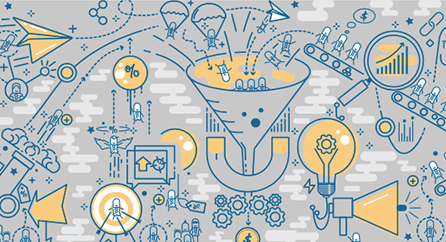
Written By: Jason Ickert | Jul 24, 2019 12:00:00 AM
During a recent TMSA conference, we participated in working lunches where several contemporary sales and marketing topics were discussed including a discussion on sales incentives and how an organization can use incentives to drive more effective revenue generation. Over two days of discussion, we had participants who held a range of roles, from individual producers to sales managers and commercial leaders; representing small logistics organizations to major publicly traded transportation companies.
In our discussions, we came to a common agreement, across the board, that incentive drives behavior. Each of our organizations were commonly bound by their membership in the transportation and logistics industry, however, each had a different strategy relative to how they motivated their sales team to reach the organizations independent revenue or sales goal.
Here are a number of individual considerations our members are including in their sales incentive strategies:
Zig Ziglar said, "If you aim at nothing, you will hit it every time." Begin with the end in mind and clearly define the desired goal. Is it revenue growth? Better margins? Number of new quotes or pipeline/customer conversions? Perhaps it’s a non-revenue goal, related to activities such as new prospect dials, conversations or scheduled meetings. It might be a learning related goal like logging either in-class or online education credits.
Whatever metrics you choose and decide to scorecard, ensure their driving the desired behavior and don't adversely impact you sales teams efficiency.
It’s been said that if you don't want to be judged by the numbers, there are two professions you should avoid; sales and sports. As leaders, we are sensitive to what motivates our team and public shaming may not always drive performance…not to mention, there is little value in seeing the top, most experienced revenue generators exchange ranking month after month. As a leader, you know those folks are going to perform consistently. It’s the B, C, and D players that you want to have a greater impact in the game.
Sales people are competitive by nature, and some are more motivated when they lose than when they win…but all are motivated to win. Choosing goals and creating performance related games among an entire sales team keeps the job interesting and each person engaged. You can create your own game and manual scorecarding process, or there are a number of digital applications which integrate with your CRM or ERP that provide scoring and ranking in real time.
Can you age out of an incentive? What types of incentives motivate individual sales members to perform? Younger team members might prefer a team reward, something experiential, that bonds them with other team members; such as a high rope course or an escape room. Others, at a more seasoned age might prefer monetary incentives. Perhaps for the top performers, a getaway with a +1, or social event with executive management may be the right choice. At the end of the day, knowing your team and what motivates the desired behavior is key to any incentive plan.
How you weight the salary and balance it with incentives when determining total compensation will determine the makeup of your sales team and their level of motivation. In the perfect world, a CEO or President, and definitely the CFO, would like to have everyone on an incentive only plan where they essentially eat only what they kill. Competition in our industry, for the most part, dictates that we balance sales compensation plans with a base salary component…or at the very least, a draw against future incentives.
How the base and incentive components were weighted, however, varied among the roundtable participants and some for a reason. For example, one participant had a sales team focused on selling in a defined territory against a growth goal. By definition, when territories have boundaries, incentive potential is limited, and thus the compensation plan might be more heavily weighted toward a larger base salary. This sales leader was focused more on attracting the sales "farmer." The field was plowed. All the farmer needed to do was plant the seeds, water the crop, and harvest.
Another attendee was using their incentive plan to attract a sales team that was needed to sell a less complex service, more of an entry level sales position that did not require a large base salary component. There are no defined territories, and their list of customers was unsaturated. In this example, the sales leader adopted an incentive plan that was weighted more heavily toward the incentive side, creating "hunting" culture, motivating their sales team members to more aggressively chase revenue in the wild.
How often an incentive is paid out can drive a certain behavior. Is the payout weekly, monthly, quarterly or annually? Perhaps certain goal incentives are paid out more often, like revenue or gross profit related incentives, while other longer or larger goal related incentives are paid out quarterly or once a year. Especially with younger sales team members, who have grown up in a culture of immediate satisfaction, an annual incentive based on a lofty corporate goal may not be enticing as a strong hotter term incentive that a person can impact and realize immediately. Striking the right balance based on your sales demographic and how they like their performance to be rewarded is key.
This is usually a mechanism deployed in organizations who have a high incentive to salary ratio, have weekly or monthly incentive payouts, or are trying to create a culture where company financial and individual performance are inextricably linked. The reason behind tying incentive payouts to receivables is generally understood by many in sales. However, this methodology usually creates additional complexity in compensation programs, and can hurt individual sales efficiency as the sales team member may become more interested in customer aging reports and occasionally put on a bill collector's hat to speed up an owed incentive.
Among our roundtable attendees, there was a preference for paying incentives when they were realized, and if need be, make future adjustments or claw back against bad debt.
One of the most popular reasons why industry professionals attend TMSA events, is the peer learning and benchmarking. What we discovered in our roundtable discussions was no two incentive plans were alike. Each has customized components that are intended to drive a certain sales behavior, while at the same time appealing to the culture of the sales team and their organization.
By Jason Ickert, Integrated Logistics Manager of Energy Transportation Group. Jason is a seasoned commercial leader with more than 25 years' experience in the global logistics space developing creative and innovative supply chain solutions to North America's largest shippers. In his role with ENERGY, Jason is responsible for client engagement, sales strategy, and sales learning & development.
seasoned commercial leader with more than 25 years' experience in the global logistics space developing creative and innovative supply chain solutions to North America's largest shippers. In his role with ENERGY, Jason is responsible for client engagement, sales strategy, and sales learning & development.
Tags: Sales

During the 2018 TMSA Logistics Marketing & Sales Conference this week, attendees had their choice of 20 topics that involved peer-to-peer discussion on opportunities, challenges and best practices...